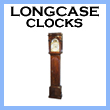
Mobile: 07860 230888
osame2@aol.com

About Longcase Clocks
Following the introduction of the pendulum in 1658 in London, the production of clocks with a case began in order to be able to put clocks somewhere else than on the wall or shelf. Also, the long pendulum, which needed a lot of protection, created the need for long cases and the clockmakers started making some very attractive cases which followed the fashion at the time.
You need a clockmaker (giving its name to the clock), a case-maker (unidentified) and if the dial is painted, the dial-maker (sometimes its name is hidden behind the dial).
The clock will loose some of its value if it has been altered. Prices have quickly increased, especially for the completely original clocks. As for every antique, the better the condition, the higher the price. Also the colour, patina and proportion play a major role. It is important to note that some case styles are not popular and the price may appear as a bargain.
There are two types of striking:- by the countwheel or by the rack, but the latter one was not really used anymore on longcase clocks after 1720.
A compatible marriage (components put together to form a whole), is when parts are from the same period and this would not affect the price too much, however be aware of marriage of movement, case and dial which will greatly devaluate the price of a clock.
View all our Longcase Clocks.







